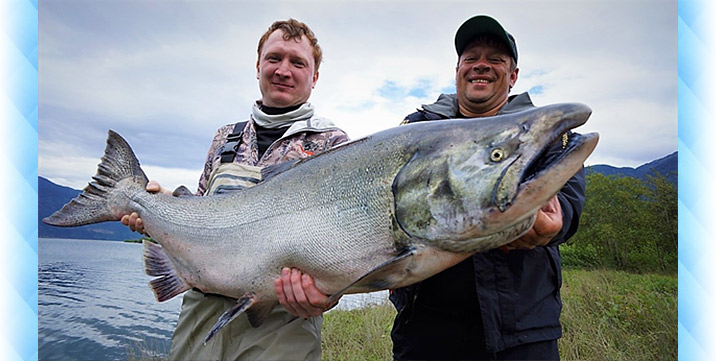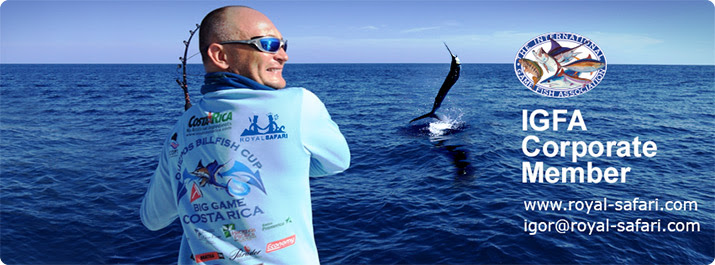|
The fishing report is remarkable, as during our fishing a new world record for the Chinook salmon was set. In March, 2017 Evgeny Danilichev, his friends, and me went to Chile. This Latin American country is famous for outstanding specimens of the largest of salmon species. In 2015 we were able to catch here a magnificent Chinook weighing 28 kilos. |
 |
|
So, this time we had the experience gained during our previous trip to Chile, and we also understood the specificity of the tackle selection for the given area of fishing. |
 |
|
The population of the “king salmon” is not so numerous here, comparing to Alaska, where I regularly fish and where our clients can observe the mass migration of Chinook to spawn every year. The main peculiarity of fishing for Chinook in Chile is the longer freshwater migration route. In Alaska or Kamchatka the fish is migrating to spawn within 3-4 weeks with the peak of 10-14 days, in Chilean Patagonia entering some rivers can continue up to 2.5-3 months. The concentration of the fish here is not so great. 1-2 trophies a day is considered to be a good result even for an experienced angler. |
 |
|
We went to the river where the Chinook season starts at the beginning of February and ends at the end of April. Besides Chinook, it is possible to fish here for the rainbow trout, steelhead salmon, sea trout, Atlantic salmon, coho, tuna, mackerel, and snook in the sea. |
 |
|
We spent one day in Santiago, got acquainted with the great Chilean cuisine, tasted local wine at the winery, and then flew to Puerto Mont. If you happen to be here, don’t miss the opportunity to visit the local seafood market and a small restaurant located close by! You will be amazed by the variety of shellfish, the quality of the local oysters and sea urchins. And the seafood soup can compete with the best buoyabes cooked in any part of the world. |
 |
|
Having enjoyed the seafood and taken photos with sea lions, we went by a private plane to the area of fishing. |
 |
|
The flight over the coast of Chile can be considered a separate excursion due to the diversity of the coast, numerous islands and bays of various shapes. |
 |
|
We landed, got acquainted with the guides, and headed towards our lodge where a font with hot water and a beautiful river and mountain view was waiting for us. |
 |
|
We washed off the stress, got settled in our cozy rooms, and gathered at a large table to celebrate our arrival. |
 |
|
A long trip was rich in emotions, and the guys highly appreciated the restaurants and excursions chosen by me. By the time of our arrival, everyone had already managed to rest from work, acclimatize, and now was looking forward towards a great fishing. |
 |
|
The next morning we were divided into two groups: 2 boats went to the bays to fish in the sea, and 2 boats stayed on the river to fish for the Chinook and trout. |
 |
|
Evgeny Danilichev, Georgy Galynsky, Sergey Kuleshov, and I went for sea trophies. The location of the lodge is ideal – exactly in between the sea and the lake. We got to the sea fishing spot in an hour and began preparing the tackle. We used the spinning rods brought for the Chinook salmon. Short spinning rods with the length of 2 m 10 cm, the test of 30-40 g, 4000 reels, fishing lines with the test of 50 lb, leads with the length of 25 cm and the test of 25 kilos. We used usual silver lures. I liked catching tuna with the Kastmaster for its perfect balance and aerodynamic design. |
 |
|
Now and then, the water in the bay “boiled”, and the flocks of tuna tore small sardines into pieces, the sardines tried to escape jumping out of the water, but were immediately attacked by the whole flock of seagulls. I think, a lot of our readers have been fishing for tuna in the ocean, but fishing with lures and relatively light for the sea fishing spinning rods turned out to be the most excitable. The flocks were moving very fast and we had to pursue them trying to guess the direction of the frightened sardines. |
 |
|
Having caught plenty of tuna, we decided to fish for the mackerel. This fish moves even faster than the tuna and hunts in flocks too. It was not difficult to distinguish mackerel flocks from tuna, as they appeared only for 30-40 sec, and sometimes, the silhouettes of these predators completely flew out of the water. Having got used to doing long casts behind the mackerel flocks and sinking the lures a little, we caught a few magnificent trophies. |
 |
|
Evgeny guided by the echo sounder sank his bait deeper and was able to catch a medium sea bass. The guides got excited, talked a lot about the taste qualities of the trophy and told us the recipe of the fish soup which could be cooked in the lodge. We were a little bit tired of tuna and mackerel, so, we accepted the offer to fish for smaller species with enthusiasm. Soon, we got a sufficient number of bass. One of Evgeny’s casts resulted in a powerful strike and while he was fighting against an invisible monster, we guessed what large fish could strike at the bottom. After 20 min of the intense struggle we understood that the trophy was a serious one, and finally we managed to define the species. Evgeny caught a mackerel of a record size. |
 |
|
For such cases, I had a certified meter and a list of records for the species that could be our potential trophies. We saw that the fish was much longer than the current world record for length (84 cm), we carefully took it aboard and registered a new world record of 95 cm. The measurement is implemented from the nose to the middle of the tail and there is no need to kill the fish to register the record, all you need to do is to take the photos and fill in the application. |
 |
|
After such a pleasant event, we decided to stop the sea fishing, enter the river, have lunch, and fish for the Chinook. We went to one of my favorite Chinook places after lunch. It is a small bay close to the main current. There is everything here: a shallow, a deep pit, a snaggy section of the river with the calm current, and an abrupt change in the depth. We started to fish around the bay, and from time to time saw Chinook coming out to the surface. I had a strike on the first cast, but, unfortunately, could not realize it. I caught the first Chinook in a few minutes. We took some photos with the trophy and went on fishing. We had some more strikes, but only one more trophy. |
 |
|
We were fishing with wobblers which had been quite good during our previous fishing in Chile. We used BRAD´S MAG WIGGLER baits which are much more efficient in Chile than the rest of baits including Blue Fox or any other lures. |
 |
|
The next day all the anglers went to the lake. I travel a lot around the world with our clients, but this time, even I was impressed with the unreal beauty of the lake and surrounding mountains. |
 |
|
Just imagine the glaciers and snow white caps of the mountains glistening in the sun, the turquoise color of water and sandy beaches. It is one of the most beautiful places in the world for the rainbow trout and sea trout fishing. The lake provides its inhabitants with the excellent forage and due to this the rainbow trout can grow up to 5 kilos, and the sea trout up to 9. |
 |
|
The guys were fishing with spinning rods, while I chose fly fishing. I can’t say which way of fishing was more efficient, as we had practically the same number of strikes. As for me, fly fishing and trout are closely connected, and I enjoyed every fish I caught. But the most remarkable was the largest rainbow trout I caught that day. |
 |
|
We were fishing on nymphs and sinking lines. When it got dark, I noticed an insect fallen on the water, it was immediately eaten by a trout. I chose a dry fly about the same size, changed the line into a floating one and sent the bait to the same place. As soon as the fly touched the water surface the trout came out, but missed the bait. The second strike was a success. The trout jerked into the thickets of water lilies, but I managed to turn it around and pull into the open space. The guide told me to hold the rod up as there were a lot of algae at the bottom and not to let the fish leave the surface. That was easy to say, but quite hard to do. The trout was strong enough, and only when it was completely dark, I was able to lead it into a scoop-net. We took a few photos with it and let it go. |
 |
|
Everyone enjoyed the lake fishing, and the barbecue on the beach was the best for the whole trip. The guides did their best to cook delicious meat on charcoal. |
 |
|
We swam, sunbathed, and took photos at the background of the snow-capped mountains while the trout were jumping in front of us, urging us to return to fishing. |
 |
|
We had a lot of exciting moments during this unforgettable fishing, but Georgy Galynsky had the best. On the last day of our fishing, the weather was the most favorable for the Chinook salmon: the fog, the cloudy sky, and a drizzling rain. The thing is, the “king salmon” in Chile is extremely weather-sensitive, and the worse the weather conditions for anglers the more the number of strikes. |
 |
|
Evgeny Danilichev and I were fishing on wobblers in the river bed when we saw a huge fish coming out of the water. The Chinook jumped out of the water more than one meter and in a few seconds jumped out again, but this time 30 meters upstream. First, I thought it was a dolphin as there are a lot of them in the bay. By the way, sea lions and seals enter the river quite often in Chile. But after the second jump, there were no doubts left, it was a large male going up the river in the search of a female. Such high jumps indicate its willingness to mate and its aggressiveness. Such specimens actively attack any baits passing by. |
 |
|
We cast several times across the monster’s way. I had some idea about the speed of the fish and called Georgy (who was fishing 700 meters upstream) on the radio. We told him about the huge, aggressive monster we had seen. I designated the distance from the shore and asked him to “pierce” with a wobbler the section of the river strictly perpendicular to the shore. In 15 min, the guide informed us that Georgy was fighting against the fish of an outstanding size. When we came to the shore, we saw happy Georgy and the largest Chinook we had ever seen. |
 |
|
The fish was 120 cm long, which was 4 cm longer than the previous world record for length set here in 2015. The weight of the fish was 32 kilos, so, we improved our personal best which had been set during our previous fishing in Chile. We registered Georgy’s trophy in accordance with all the rules of the International Game Fish Association (IGFA) and let it go, as such specimens are the gene pool of the whole population of the Chinook salmon and give the opportunity to catch more outstanding trophies in the future. The scientists think that salmon give their next generations not only the information about the place of birth, but also the information about the areas rich in forage. It is the fodder base which provides the record specimens with everything they need to grow, and together with excellent genetics contribute to the future growth of the next generations of salmon. |
 |
|
The largest in weight Chinook salmon was caught in Alaska in 1985, but we hope to improve this record in the nearest future. It goes without saying that there are larger specimens in Chile, and the only question is when the new record will be set. We are inviting you to join our Chinook expeditions in Chile! |
 |
|
The season on the river is quite short (the end of February – the beginning of April) that is why it is necessary to book the top dates in advance. It’s high time to think about the upcoming season! We can offer other options of the fishing tours in Chile at low price, but only here you will have the opportunity to fish in fresh and salt water. Write to the e-mail and we will answer all the questions. |
|
In the upcoming season we are ready to arrange an excellent fishing for you in the hottest fishing spots of our planet! |
 |
 |



















